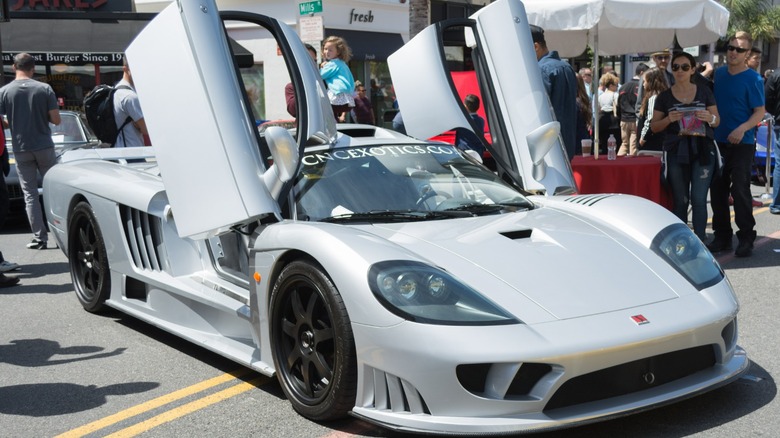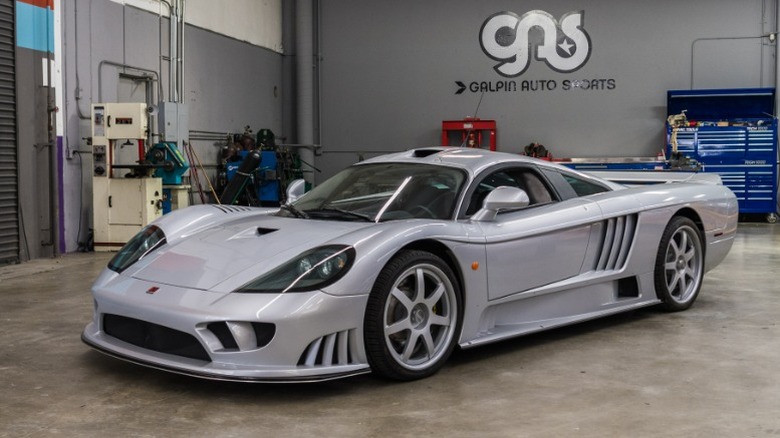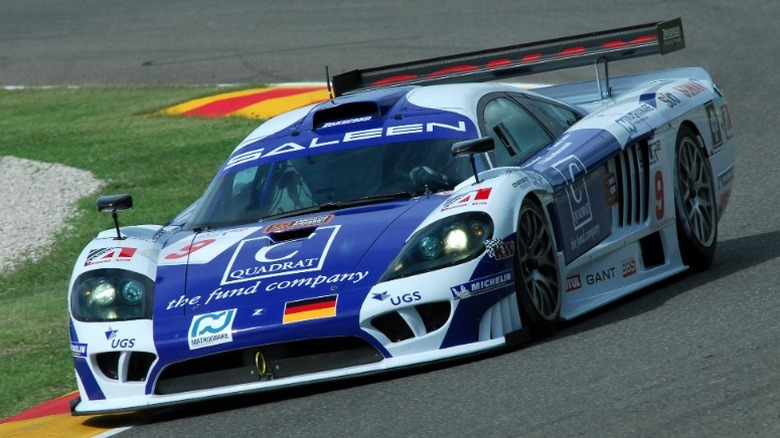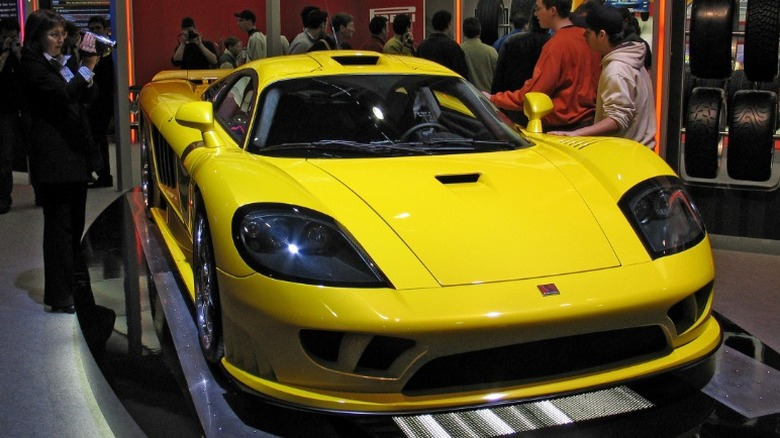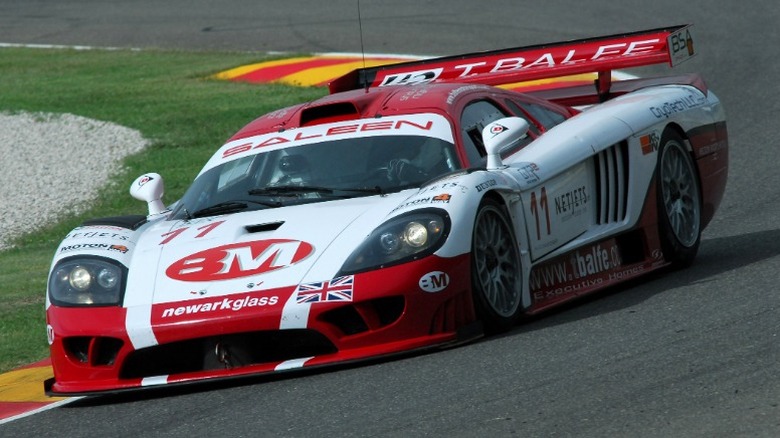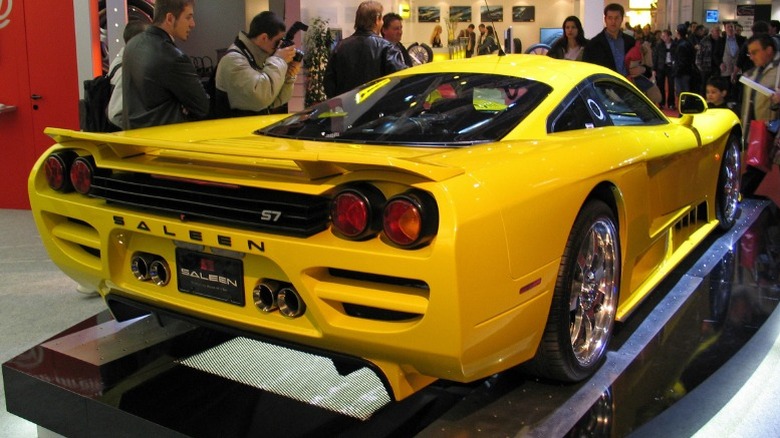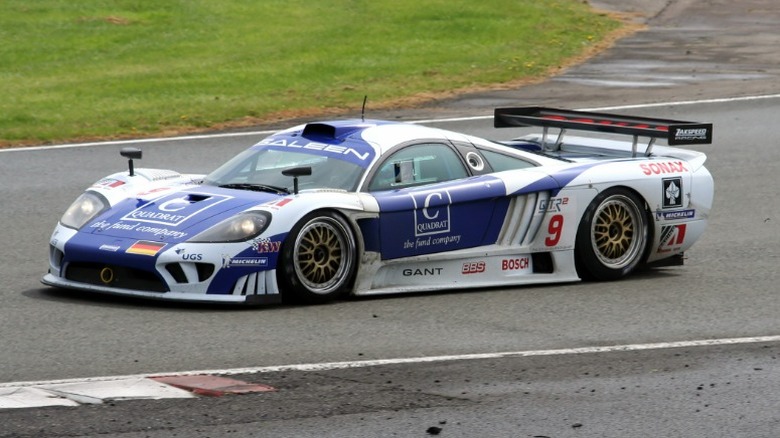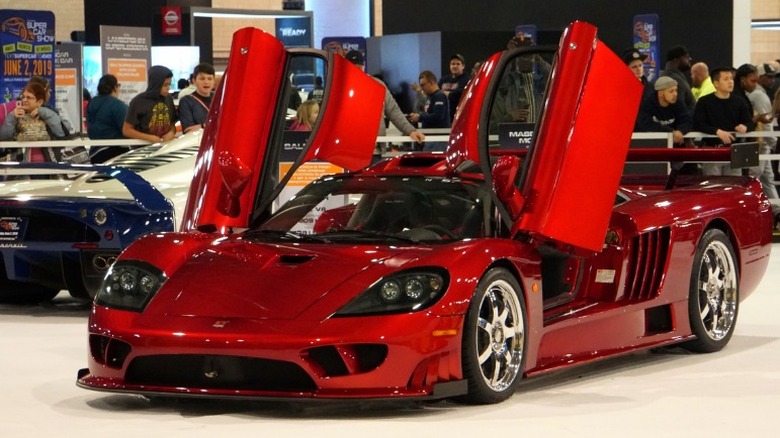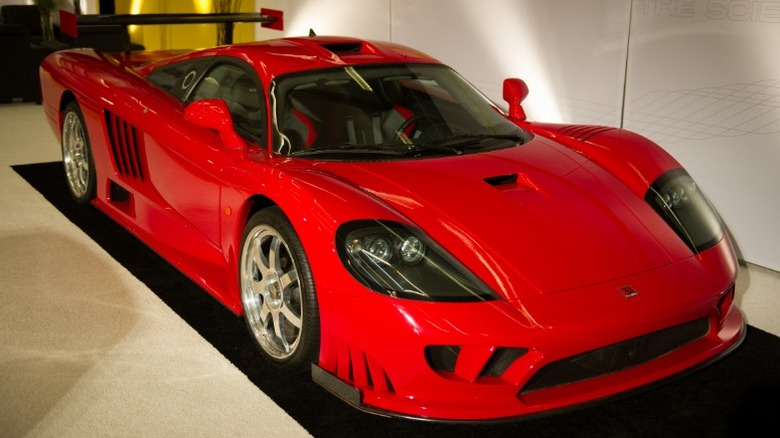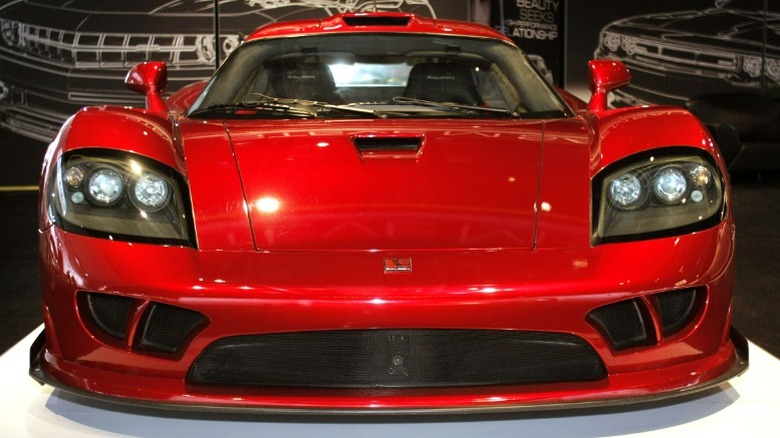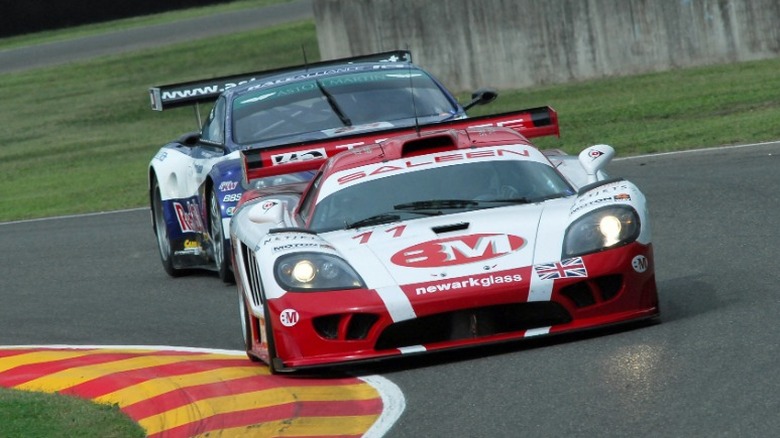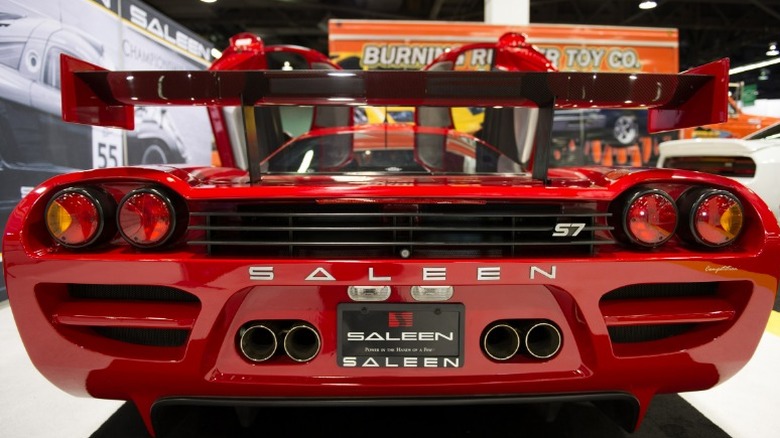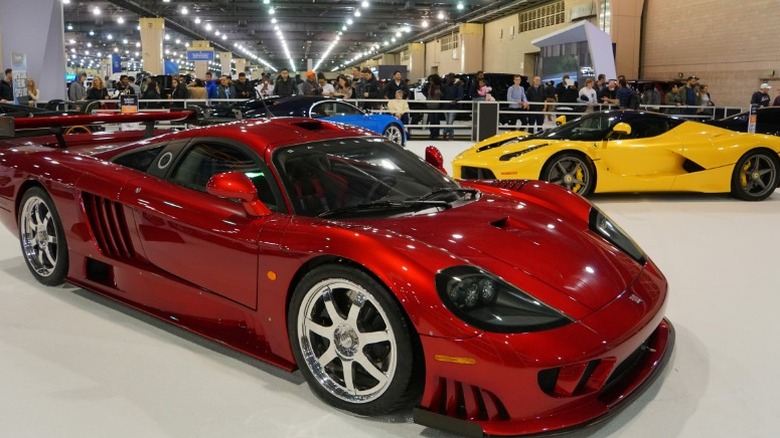Facts Every Supercar Lover Should Know About The Saleen S7
Saleen Automotive was once known exclusively as a high-performance tuner for Ford Mustangs. CEO Steve Saleen stated: "Our signature line of Saleen [Mustang] 302s sets the bar for vehicles that are not only great looking and deliver premium performance but also maintain an affordable price level so that any enthusiast vehicle buyer can find a car that fits their need." However, in 2000, Saleen introduced a mid-engine car that would vault the company into the supercars domain to compete with Ferrari, Lamborghini, Pagani, and others.
Although the Vector W8 Twin Turbo is the first legitimate mid-engine supercar produced in America, only 19 Vectors were manufactured from 1990 to 1993. Nevertheless, the Vector set the stage for the Saleen S7, launched in 2000, and the Ford GT produced from 2004 to 2006 (about 4000 units).
At its introduction, the S7 was the most powerful and technologically advanced street-legal car made in the U.S. It helped secure the Saleen Ford GT contract in 2002 to engineer, develop, and assemble the Ford GT40. The company designed and tested the body, chassis, powertrain, electrical systems, and interior.
Most supercar enthusiasts are familiar with the fantastic performance of Saleen's street and track vehicles. However, there are some facts about the car that even Saleen fanatics might not know.
From S7 design concept to production in 18 months
The new car manufacturing process can be broken down into five major steps: Invention, design, engineering, manufacturing, and launch. According to Torque News, "Starting with nothing more than an idea sketched on paper, the process of taking a car to a gleaming production concept on the auto show floor typically takes about three years." Car and Driver says, "on average, the entire process takes 72 months [six years]." The Saleen S7 went from design concept to production in 18 months, a feat few larger automakers could ever achieve.
When Steve Saleen began the S7 design process, he not only wanted a racecar that would challenge the best cars at the most demanding sportscar race in the world (24 hours of Le Mans), but he wanted a road vehicle with similar capabilities. As a result, both the racing and road versions were kept remarkably similar during the S7 design phase.
Since Saleen Automotive was a low-volume manufacturer, it lacked the in-house expertise to build a new car. So, Steve consulted with industry experts to reduce the typical design-to-manufacturing time. While the final assembly was done in California, the chassis was built by Great Britain's Ray Mallock racing house. The aerodynamic design and wind tunnel testing were completed at the University of Glasgow in Scotland, and Steve and Phil Frank designed the S7's body and interior.
A road-capable race car
When Steve Saleen began designing the S7, he gave his engineers the task of creating a road-capable automobile that featured racecar characteristics. Saleen built the road-legal Saleen S7 with only a few mechanical differences from its race car, the S7R. Engine emissions on the road version met mandated government requirements. The shock tuning and spring rates were tuned for street driving. The interior was finished in leather, seldom found in a race car.
Although removing the steering wheel is not required to enter the car (like a Formula One race car), some flexibility and contortion are necessary to climb in the cramped cockpit. Once inside, the visibility of the S7 road car matches a typical race car: poor in every direction except straight ahead. The engine noise is loud enough to discourage conversation, and road noise enters the cabin unabated.
The heavy brake pedal is designed for harsh or aggressive braking, and the steering is far more sensitive than a typical high-performance sports car. Motor Trend claimed, "especially at first, we had to devote a fair portion of our available attention to keeping a relaxed grip on the tiny wheel and gently pressing on it to manage heading changes without over-control. The combination of racecar steering, a race-derived suspension, a chassis more ridged than the one of the Ferrari Enzo, plus giant Michelin Pilot Sport PS2 tires resulted in a street-legal race car.
Big on the outside, small inside
The Saleen S7 measures 188 inches in length and 78.3 inches in width, significantly bigger than other cars in its class. By comparison, the Ferrari SF90 Stradale is 185.4 inches long and 78 inches wide. The Ferrari F8 Spider reaches 182 inches in length and 78 inches in width, and the 2005 Corvette is 175 inches long and 73 inches wide. The interior space of the Saleen S7 is typical of a supercar: snug. The scissor-type doors make the entrance and exit a bit easier than it would be with standard doors. However, both driver and passenger must climb over a massive door sill that houses the car's structure and gives the S7 exceptional rigidity.
Once inside, the position of the racing-style leather bucket seats is fixed. Moving the seat forward or backward is not possible. When purchased, Saleen installs the seats for the buyer based on the buyer's measurements, after which a company technician must make changes.
The interior of the S7 also includes offset footwells, a characteristic not found on many supercars. The floor space starts as wide as the seat but becomes much more narrow deeper into the footwells, leaving very little space for feet. The limited space is uncomfortable for the passenger and on the driver's side, the pedals are positioned close together on the right side of the footwell requiring the driver to twist the legs to reach them.
The S7 shares components with the race version S7R
The street version Saleen S7 and its racing counterpart S7R share many essential components, giving the cars similar performance characteristics. The differences are primarily mechanical, and many are required to make the S7 street legal. Both vehicles employ carbon-fiber bodywork, while the engine and suspension of the S7R are tuned for racing. The S7R chassis is fitted with additional roll cage bracing, but the brake systems for both versions are identical.
Saleen adjusted the S7 springs and shocks for street use and fitted the car with a six-speed transaxle, including full synchromesh. The engineers also slowed the overall steering ratio on the road-legal version, but it remains much more responsive than systems found on other production supercars. The S7 lacks the race-spec wheels and tires of the S7R, but it features an exhaust system with catalytic converters to meet emission standards and noise abatement requirements.
A rare mid-engine car made in the U.S.
Automobile engineers have long known the benefits of a mid-engine design over the more traditional front-mounted configuration. More weight is placed over the rear wheels, resulting in more traction and less chance of a spinout. On rear-wheel drive vehicles, the additional weight improves acceleration on a slippery surface. The benefit is similar to an all-wheel drive car without the added weight and expense.
Handling through turns is a top priority in sports cars and is best achieved with balanced traction between the front and rear wheels. An ideal balance is challenging when the heavy engine weight is far to the front or rear. Some automakers use techniques to distribute weight, such as putting the gearbox and battery in the back of a front-engine vehicle.
While mid-engine cars are more familiar to European automakers, the design has had a limited history in the U.S. The Pontiac Fiero, introduced in 1984, is often considered the first mid-engine American production car. However, until the release of the Saleen S7 in 2000, the Vector W8 Twin Turbo and the M12, built in limited quantities, were the only American-made mid-engine production supercars. Today, the Corvette is the best-known American mid-engine high-performance sports car.
The fastest production car in the world in 2000
Saleen used a combination of 550 horsepower, carbon fiber construction, and state-of-the-art aerodynamics to create the S7, the fastest car on the market in 2000 at 220 miles per hour. It was the first American car to win the speed crown in years. The S7 was quick, going from 0 to 60 mph in just 3.3 seconds.
Two high-speed supercars preceded the S7: the 1994-1998 McLaren F1 churning out 231-240 mph and the 1999 Lamborghini Diablo GT reaching 215 mph. During the following years, European supercar manufacturers continued to produce cars with a performance car enthusiasts could only dream about 40 years ago:
- 2002 Ferrari Enzo: 217 mph
- 2003 Pagani Zonda C12-S: 220 mph
- 2004 Koenigsegg CCR: 241 mph
- 2005-2006 Bugatti Veyron 16.4: 254 mph
Saleen equipped the S7 with a naturally aspirated pushrod Ford small-block V8 punched and stroked out to 7.0 liters, producing 550 horsepower (558 PS) at 5900 rpm and a maximum torque of 525 lb-ft (710 Nm) at 4000 rpm. Ford casts the aluminum block and heads to Saleen specs in molds similar to those used for its NASCAR engines. Machining on the castings involves overboring the cylinders by 0.020 inches and porting the heads. The engines are sent to Irvine, California, where Saleen builds them with a custom accessory drive featuring a side-mounted water pump.
Twin turbos bump the S7 to 750 horsepower
The S7 set its mark as one of the fastest cars ever produced in the U.S. at its introduction in 2001. However, within three years, improvements in automotive engineering made 550 horsepower much easier to attain, giving Saleen significant competition from other supercars. Not satisfied to rest on his laurels, in 2005, Steve and his engineering staff upgraded the 7.0-liter engine in the street version S7 with twin Garrett turbochargers producing 5.5 psi of boost.
The upgraded engine, including replacing the original hydraulic lifters with solid lifters, generated 750 horsepower at 6,300 rpm and 700 lb-ft of torque at 4,800 rpm. It met emissions requirements and remained compliant with OBD-II (Onboard diagnostics) standards using a state-of-the-art emission control system.
However, there were more changes to the S7 than just the addition of turbochargers. The already exceptional aerodynamic properties were improved with modified front fenders, front and rear diffusers, and a rear spoiler. The result was a 60 percent increase in downforce and a 40 percent decrease in drag. Saleen revised the S7 Twin-Turbo's suspension, making it firmer for acceleration, turning, and braking. Dual-stage shock absorbers enabled variable spring rates at different speeds. Saleen and Brembo co-developed brakes consisting of 15-inch discs in the front and 14-inch discs in the rear, improving braking ability.
Every gill opening on the S7 body serves a purpose
The S7 features 50 gills or vents in five separate locations on its body. There is a group of gills in front and behind the front wheels, in the fender above the front wheels, in front of the engine, and in the flat body panel behind the engine. The body also includes two functional air intakes, one on the front hood that connects to tubing inside the car, and the other is located over the top of the windshield and carries air to the engine. As a comparison, the Ferrari Enzo has no gills, although it does feature some vents to supply air to the engine and the passenger compartment.
The gills not only give the S7 an exotic appearance but also contribute to the aerodynamic characteristics and are essential to the performance, creating downforce and cooling. The side gills allow airflow to exit the wheel wells, which typically remain turbulent due to wheel rotation, and they can aid in cooling brake discs which generate heat during hard braking.
S7 exceptional aerodynamics
During the early stages of the S7 development, Saleen's engineers focused on aerodynamics, spending two months testing at the University of Glasgow's wind tunnel in Scotland. The result is a sleek body with an estimated drag coefficient of 0.315 Cd. Saleen claims the S7 is the most aerodynamically efficient streetcar ever built, while some experts say a drag coefficient of 0.27 is required for the car to reach a top speed of 223 mph. The Ferrari Enzo has a drag coefficient of 0.36 by comparison.
Perhaps more important than drag is the downforce produced by the car's body at high speeds and its impact on handling. Most Formula One cars are designed to maximize downforce for the best performance through the turns. The Saleen S7 body, made entirely of carbon fiber, combines gills, scoops, and spoilers to create split channel airflow throughout the car.
According to Saleen, speaking to Car and Driver, the downforce created at a speed of 160 mph equals the car's weight, which means the car could (theoretically) drive upside down on an inverted road. The effect would be similar to the scene in the movie "Men in Black" (1997) when Agent K (Tommy Lee Jones) and Agent J (Will Smith) drive upside down in the Queens-Midtown Tunnel to bypass the traffic below.
Saleen S7 outstanding racing Legacy
Saleen's competency in racing began well before the introduction of the S7. Saleen-engineered Mustangs spent more than three decades on the track. The tuner earned six manufacturers' championships in tuned Mustangs and entered two cars in the prestigious endurance race, the 24 Hours of Le Mans.
The racing record of the Saleen S7 includes victories in several classes, competing internationally in America, Europe, and Asia. The S7R immediately impacted the racing circuit, participating in thirty-two races in its first year of competition, taking the pole in twenty-seven of the races, and claiming victory in nineteen races. In the succeeding years, the S7R has also been victorious in nine additional manufacturers' championships and won the celebrated 24 Hours of Le Mans.
Steve Saleen said, "The S7 was immediately competitive in motorsports from day one, winning over 100 professional races at the world's top racetracks including Daytona, Nürburgring, Silverstone, Imola, Spa-Francorchamps and the 24 Hours of Le Mans – and that was just in the first ten years of its existence. There's a lot to celebrate with the S7 over the past two decades."
Quirky features of the Saleen S7
Although the Saleen S7 performs in the same class as the best European supercars, it has some unusual features:
- Generic taillights: Rather than make custom taillights for the S7, Saleen selected a set that meets government regulations and is used on many ordinary buses and trucks (also found on the Lamborghini Diablo, early Pagani Zanda, the Spyker C8 sports car, and the SSC Ultimate Aero).
- Reverse lights: Saleen located them in an odd spot above the license plate.
- Two trunks: One in the front and one in the rear, lined with carbon fiber on the bottom and suede on the top. In most supercars, suede is generally on the bottom to prevent objects from sliding around when the car is in motion.
- Well-hidden battery: It requires the removal of a wheel for maintenance.
- Emergency trunk release latch: It opens the trunk lid from the engine compartment.
- Odd key fob functions: 4 buttons with Roman numerals that open doors and the trunk in non-intuitive button combinations.
- Bisected spoiler: Most supercars will mount the wing as a single piece on the trunk lid, so it goes up and down with the lid.
- Backup camera: Saleen installed a backup camera, almost nonexistent in other cars of the era. It connects to a Kenwood video display (Saleen did not develop an infotainment system).
- Ford Focus turn signals: Saleen used off-the-shelf switch gear to reduce the expense of custom models.
S7 resale prices have soared in recent years
The Saleen S7 was listed for more than $400,000 when it was launched in 2000, placing it in the company of other supercars from elite automakers such as Ferrari, Lamborghini, and McLaren. Like many supercars with limited production, prices have skyrocketed in the years after the vehicle's initial release. According to Classic, 7 Saleen S7 cars were sold from Jan 2019 to Jan 2024, with an average sale price of over $730k and a high of $1.2 million*.
When it was first released to the public, the S7 Twin Turbo version cost approximately $555,000.
In 2017, Saleen celebrated the S7's worldwide racing success by creating seven LM (Le Mans) models based on the existing S7 chassis. The LM featured a 1000-horsepower version of the 7.0L V8. This limited edition vehicle had a price of $1,000,000 direct from Saleen. *The highest auction price for a Saleen S7 was for 1 of the 7 limited edition (LM) vehicles ($1,200,000) — not considering the LM, the highest auction price fetched for a Saleen S7 is still just over $1m.
